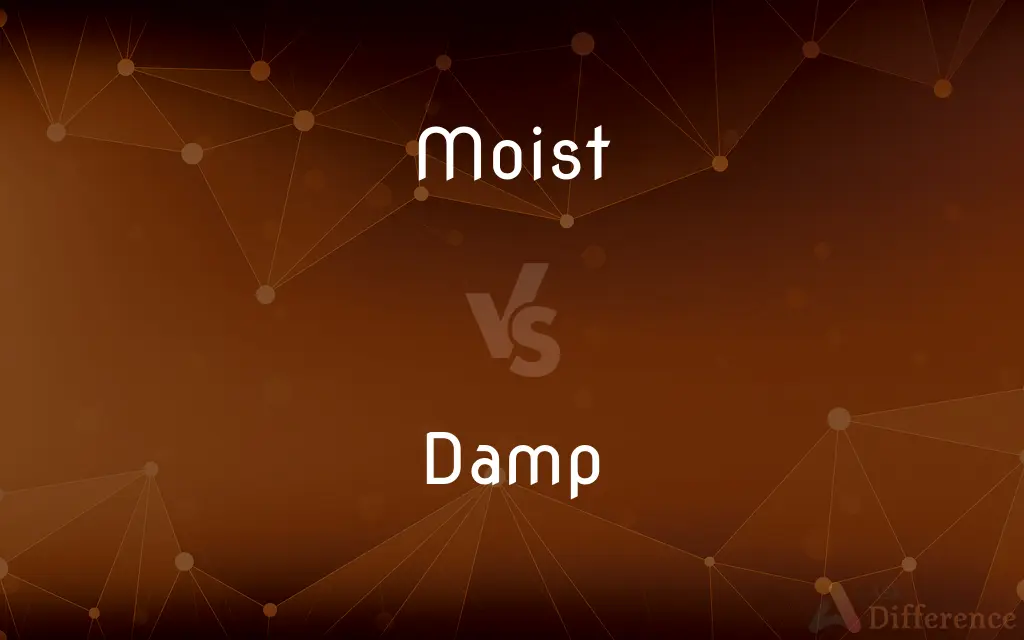Moist vs. Damp — What's the Difference?
Edited by Tayyaba Rehman — By Fiza Rafique — Updated on April 4, 2024
Moist refers to slightly wet or imbued with moisture, often in a desirable or planned way, while damp describes a level of wetness that is often unintended and potentially uncomfortable or harmful.

Difference Between Moist and Damp
Table of Contents
ADVERTISEMENT
Key Differences
Moist is commonly associated with positive contexts, such as moist air implying comfort or health, and moist cake indicating desirable texture. Damp, however, carries a negative connotation, suggesting an unwelcome presence of moisture that could lead to discomfort, decay, or damage.
While "moist" might be used to describe conditions beneficial for plant growth or skin health, indicating a balanced level of wetness, "damp" often refers to environments or materials where excess moisture presents problems, such as damp walls leading to mold.
In culinary contexts, moist describes an ideal texture in foods like baked goods, where it signifies softness and freshness. Damp, conversely, is rarely used in these contexts, as it implies a less than ideal state, such as clothing or spaces where moisture is present in a problematic way.
The perception of moisture content also differs; moist environments or items are usually characterized by a pleasant level of humidity or wetness, enhancing the experience or usability. Dampness, on the other hand, suggests a saturation point that has been exceeded, where the presence of water detracts from functionality or comfort.
Comparison Chart
Connotation
Generally positive, indicating a desirable level of wetness
Often negative, associated with unwanted or excessive wetness
ADVERTISEMENT
Contexts
Health, cooking, plant growth
Mold, decay, discomfort
Perception
Balanced, enhancing texture or freshness
Excessive, leading to problems or damage
Usability
Indicates optimal conditions (e.g., in foods or skincare)
Suggests problematic conditions (e.g., in buildings or textiles)
Desired Level
Intentional, controlled wetness
Unintentional, often due to lack of control
Compare with Definitions
Moist
Slightly wet; imbued with moisture in a beneficial way.
The cake was deliciously moist.
Damp
Unwanted moisture in textiles or clothing.
The laundry felt damp even after hours of drying.
Moist
Positive aspect of air quality.
The moist air in the rainforest supports a vast biodiversity.
Damp
Negative impact on materials or structures.
The dampness in the wood led to rot.
Moist
Indicating a desirable level of humidity for comfort or growth.
The greenhouse maintained a moist environment for the tropical plants.
Damp
Slightly wet in an undesirable manner.
The walls were damp from the leak.
Moist
Beneficial wetness in skincare.
The moisturizer left her skin feeling soft and moist.
Damp
Indicating a level of wetness that could lead to discomfort or damage.
The damp basement smelled of mold.
Moist
Describing an optimal texture in food.
The bread’s moist interior contrasted its crusty exterior.
Damp
Excessive humidity affecting living conditions.
Damp air in the house aggravated her allergies.
Moist
Slightly wet; damp
A moist sponge.
A dog's moist nose.
Damp
Slightly wet
A damp sponge.
Moist
Humid
The moist gulf air.
Damp
Humid
Damp air.
Moist
Characterized by considerable rainfall; rainy
A moist climate.
Damp
(Archaic) Dejected; depressed.
Moist
Juicy or succulent; not dried out
Basting keeps the turkey moist in the oven.
Damp
Moisture in the air; humidity
Come in out of the damp.
Moist
Tearful
Moist eyes.
Damp
Moisture that lies or has condensed on something
“I saw the damp lying on the bare hedges and spare grass” (Charles Dickens).
Moist
Characterized by the presence of moisture; not dry; slightly wet; damp.
Damp
Foul or poisonous gas that sometimes pollutes the air in coal mines.
Moist
Of eyes: wet with tears; tearful; also (obsolete), watery due to some illness or to old age.
Damp
Lowness of spirits; depression
“An angry or sorrowful [countenance] throws a sudden damp upon me” (David Hume).
Moist
Of a climate, the weather, etc.: damp, humid, rainy.
Damp
A restraint or check; a discouragement
“The issue of arms was so slow as to throw a great damp upon volunteering” (James Franck Bright).
Moist
(medicine)
Damp
To make damp or moist; moisten.
Moist
Characterized by the presence of some fluid such as mucus, pus, etc.
Damp
To suppress or extinguish (a fire) by reducing or cutting off air.
Moist
Of sounds of internal organs (especially as heard through a stethoscope): characterized by the sound of air bubbling through a fluid.
Damp
To restrain or check
News that damped our enthusiasm.
Moist
Pertaining to one of the four essential qualities formerly believed to be present in all things, characterized by wetness; also, having a significant amount of this quality.
Damp
(Music) To slow or stop the vibrations of (the strings of a keyboard instrument) with a damper.
Moist
(obsolete)
Damp
(Physics) To decrease the amplitude of (an oscillating system).
Moist
Fluid, liquid, watery.
Damp
In a state between dry and wet; moderately wet; moist.
The lawn was still damp so we decided not to sit down.
The paint is still damp, so please don't touch it.
Moist
Bringing moisture or rain. a. 14th – 18th c.}}
Damp
(figuratively) Despondent; dispirited, downcast.
Moist
Moistness; also, moisture.
Damp
Permitting the possession of alcoholic beverages, but not their sale.}}
Moist
(transitive)
Damp
Moisture; humidity; dampness.
Moist
To make (something) moist or wet; to moisten.
Damp
(archaic) Fog; fogginess; vapor.
Moist
To inspire, to refresh (someone); also, to soften (one's heart).
Damp
(archaic) Dejection or depression; something that spoils a positive emotion (such as enjoyment, satisfaction, expectation or courage) or a desired activity.
Moist
(intransitive)
Damp
A gaseous product, formed in coal mines, old wells, pits, etc.
Moist
(US) To rain lightly; to drizzle.
Damp
To dampen; to make moderately wet
To damp cloth
Moist
(obsolete) To have an effect of moistening or wetting.
Damp
To put out, as fire; to weaken, restrain, or make dull.
Moist
Moderately wet; damp; humid; not dry; as, a moist atmosphere or air.
Damp
(transitive) To suppress vibrations (mechanical) or oscillations (electrical) by converting energy to heat (or some other form of energy).
Moist
Fresh, or new.
Damp
Moisture; humidity; fog; fogginess; vapor.
Night . . . with black airAccompanied, with damps and dreadful gloom.
Moist
To moisten.
Damp
Dejection; depression; cloud of the mind.
Even now, while thus I stand blest in thy presence,A secret damp of grief comes o'er my soul.
It must have thrown a damp over your autumn excursion.
Moist
Slightly wet;
Clothes damp with perspiration
A moist breeze
Eyes moist with tears
Damp
A gaseous product, formed in coal mines, old wells, pints, etc.
Damp
Being in a state between dry and wet; moderately wet; moist; humid.
O'erspread with a damp sweat and holy fear.
Damp
Dejected; depressed; sunk.
All these and more came flocking, but with looksDowncast and damp.
Damp
To render damp; to moisten; to make humid, or moderately wet; to dampen; as, to damp cloth.
Damp
To put out, as fire; to depress or deject; to deaden; to cloud; to check or restrain, as action or vigor; to make dull; to weaken; to discourage.
Usury dulls and damps all industries, improvements, and new inventions, wherein money would be stirring if it were not for this slug.
How many a day has been damped and darkened by an angry word!
The failure of his enterprise damped the spirit of the soldiers.
Damp
A slight wetness
Damp
Deaden (a sound or noise), especially by wrapping
Damp
Restrain or discourage;
The sudden bad news damped the joyous atmosphere
Damp
Make vague or obscure or make (an image) less visible;
Muffle the message
Damp
Lessen in force or effect;
Soften a shock
Break a fall
Damp
Slightly wet;
Clothes damp with perspiration
A moist breeze
Eyes moist with tears
Common Curiosities
Is moist air good for health?
Yes, moist air can be beneficial, especially for respiratory health, as it helps keep mucous membranes hydrated.
Can food be too moist?
Yes, if moisture compromises the texture or leads to sogginess, it can be considered too moist.
How can I reduce dampness at home?
Improve ventilation, use dehumidifiers, fix leaks, and ensure that the home is well-heated during cold weather.
Is it possible for skin to be too moist?
Excessively moist skin, especially without proper air circulation, can lead to skin issues like maceration or fungal infections.
Why is damp considered negative?
Damp conditions can lead to mold growth, structural damage, and health issues, making them generally undesirable.
How do I keep baked goods moist?
Proper ingredient balance, adequate baking time, and storing in air-tight containers can help maintain moisture.
Why do some people dislike the word moist?
It's often a personal or cultural preference, sometimes related to the word's associations or sound.
Does damp always lead to mold?
Not always, but damp conditions significantly increase the risk of mold growth.
Can a room be both moist and damp?
Technically, yes, if it has a beneficial level of moisture for certain purposes (like plant growth) but also problematic wetness affecting other aspects (like walls or furniture).
How can I tell if my house is damp?
Signs include musty odors, visible mold, wet spots on walls or ceilings, and a general feeling of moisture in the air.
What causes damp in buildings?
Common causes include leaks, condensation, and inadequate ventilation or heating.
Can dampness affect electronics?
Yes, damp conditions can corrode electronic components and lead to malfunction.
How does moisture content differ between moist and damp materials?
Moist materials have a controlled amount of moisture that is usually beneficial, whereas damp materials have excessive moisture that is often harmful.
Can plants be damp?
Yes, plants can be damp, which can be problematic if it leads to fungal diseases.
Is dampness a problem in all climates?
Dampness can be a problem in various climates, particularly those with high humidity or significant rainfall.
Share Your Discovery

Previous Comparison
Lounge vs. Restaurant
Next Comparison
Annually vs. AnnualAuthor Spotlight
Written by
Fiza RafiqueFiza Rafique is a skilled content writer at AskDifference.com, where she meticulously refines and enhances written pieces. Drawing from her vast editorial expertise, Fiza ensures clarity, accuracy, and precision in every article. Passionate about language, she continually seeks to elevate the quality of content for readers worldwide.
Edited by
Tayyaba RehmanTayyaba Rehman is a distinguished writer, currently serving as a primary contributor to askdifference.com. As a researcher in semantics and etymology, Tayyaba's passion for the complexity of languages and their distinctions has found a perfect home on the platform. Tayyaba delves into the intricacies of language, distinguishing between commonly confused words and phrases, thereby providing clarity for readers worldwide.















































